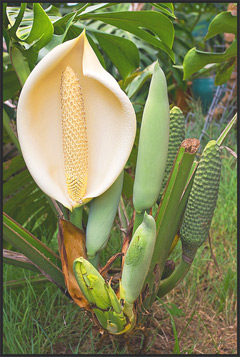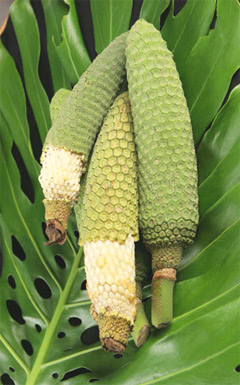|
|
Monstera Deliciosa: Energy Booster

Monstera deliciosa is a species of flowering plant native to tropical
rainforests of southern Mexico, south to Colombia. It has been introduced to
many tropical areas, and has become a mildly invasive species in Hawaii.
The specific epithet deliciosa means "delicious", referring to the edible fruit.
Common names include ceriman, Swiss cheese plant (or just cheese plant), fruit
salad plant, monster fruit, monsterio delicio, monstereo, Mexican breadfruit,
locust and wild honey, windowleaf, balazo, and Penglai banana. This member of
the arum family Araceae is an epiphyte with aerial roots, able to grow up to 20
m (65 feet) high with large, leathery, glossy, heart-shaped leaves 25�90 cm (9
to 35 inches) long by 25�75 cm broad. Young plants have leaves that are smaller
and entire with no lobes or holes, but soon produce lobed and fenestrate leaves.
Wild seedlings grow towards the darkest area they can find until they find a
tree trunk, then start to grow up towards the light, creeping up the tree.
The plant is commonly grown for interior decoration in public buildings and as a
houseplant. It grows best between the temperatures of 20�30 �C (68�86 �F) and
requires high humidity and shade. Growth ceases below 10 �C (50 �F) and it is
killed by frost. In the coastal zones of Sicily, especially in the Palermo area,
where it is called "zampa di leone" ("lion's paw"), it is often cultivated
outdoors. In ideal conditions it flowers about three years after it is planted.
Flowering is rare when grown indoors. The plant can be propagated by taking
cuttings of a mature plant or by air layering. This species and the cultivar 'Variegata'
have gained the Royal Horticultural Society's Award of Garden Merit.
The fruit is up to 25 cm long and 3�4 cm diameter, looking like a green ear of
maize covered with hexagonal scales. Fruits of plants of the Araceae (Arum
family) often contain Raphides and Trichosclereids � needle-like structures of
calcium oxalate. The fruit may be ripened by cutting it when the first scales
begin to lift up and it begins to exude a pungent odor. It is wrapped in a paper
bag and set aside until the scales begin popping off.
The scales are then brushed off or fall away to reveal the edible flesh
underneath. The flesh, which is similar to pineapple in texture, can be cut away
from the core and eaten. It has a fruity taste similar to jackfruit and
pineapple. The unripe green fruits can irritate the throat and the latex of the
leaves and vines can create rashes in the skin, because both contain potassium
oxalate: that is the reason why the fruits have to be consumed when the scales
lift up.
Plants grown indoors in temperate regions occasionally produce flowers and
fruit.
The aerial roots have been used as ropes in Peru, and to make baskets in Mexico.
In Mexico, a leaf or root infusion is drunk daily to relieve arthritis. In
Martinique the root is used to make a remedy for snakebite. In Colombia it is
used as a decorative plant.
Health Benefits of Monstera Deliciosa Fruit
 Monstera Deliciosa Fruit must be totally ripe to be eaten otherwise it�s toxic.
It has a taste similar to Banana and Pineapple mixed together�Wonderful! And the
taste changes depending on how long the fruit has been ripe� different flavors
coming out all the time such as guava and passion fruit. Monstera Deliciosa Fruit must be totally ripe to be eaten otherwise it�s toxic.
It has a taste similar to Banana and Pineapple mixed together�Wonderful! And the
taste changes depending on how long the fruit has been ripe� different flavors
coming out all the time such as guava and passion fruit.
-
Monstera Deliciosa Fruit is loaded with lots of Vitamin C.
-
It contains 60 mg per 100 grams of fruit, more than 22 grams of protein,
lots of good carbs, some B Vitamins, almost no fat, calcium, and phosphorus.
-
Monstera Deliciosa Fruit is full of large amounts of Vitamin C, which is
a great antioxidant that keeps away disease.
-
Some athlete�s take Monstera Deliciosa Fruit made into a smoothie is
great for instant energy and increased stamina. And if you have a long run,
swim, or bike trek ahead of you Monstera Deliciosa will provide the calories
you need to get you going.
-
It�s great for those recovering from radiotherapy.
Monstera Deliciosa Fruit taste-"On the first day of the fruit, when picked, its
flavour is like guava, and the second day it is like mangosteen, and the third
day it is like lychee, the fourth is passion fruit taste, the fifth is sweetsop
fruit; the sixth up to the eighth is grape fruit nature of taste." �The best
flavour is on the ninth day where the fruit becomes perfectly ripe which tastes
sweet and smells good.
Dated 11 February 2014
|
|
|
|
|









